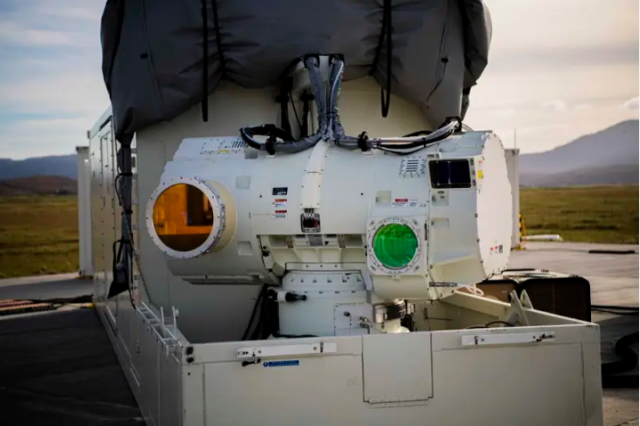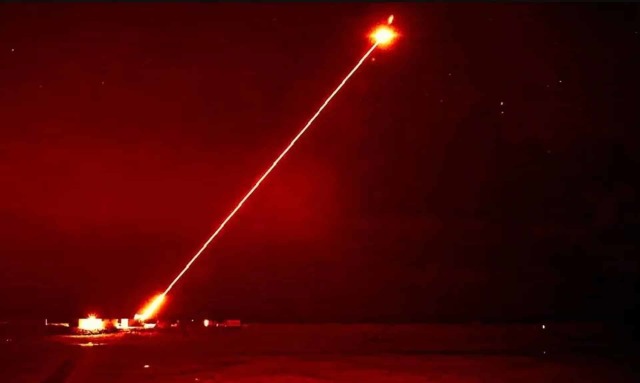The UK has fired at aerial targets with its new weapon, the powerful Dragonfire laser. Despite a press release from the Ministry of Defense of the United Kingdom issued at the end of the tests, there were no more details about the new installation. Information about it is still classified — at least as far as the range is concerned. Experts believe that this laser is likely to become an inexpensive alternative to air defense missiles. With its help, it will be possible, for example, to shoot down drones.
Modern anti-aircraft missiles effectively destroy aerial targets. But there are a number of problems with such ammunition. First, there is a limited supply: missile systems must be recharged after the consumption of a set of ammunition, which wastes time, especially precious in war conditions. Secondly, missiles are very expensive: the price of one piece can reach several million dollars. Thirdly, expensive missiles often have to be spent on shooting down small cheap kamikaze drones, the cost of which usually does not exceed several tens of thousands of dollars.
A good alternative to such ammunition is lasers, which have a number of advantages. Unlike anti-aircraft missiles, which have a finite speed and height of destruction, each "shot" of a laser air defense system flies at the speed of light and much higher than a rocket. In addition, laser weapons can hit multiple targets with minimal pauses, and the price of one shot from such an installation in some cases is no more expensive than a cup of coffee (the cost of a shot of Israel's Iron Ray laser system is two US dollars).
The leading military powers have been developing laser weapons since the middle of the last century. Today, Israel, China, and the United States have it. For example, laser air defense is installed on some American destroyers. However, for some reason, the United States does not shoot down Houthi drones with it, but uses missiles instead (a number of industry observers believe that the Americans have not yet brought such systems to mind). Recently, laser air defense appeared in the UK. The installation called Dragonfire ("Fire-breathing Dragon") was tested by the British military on January 19 at a training ground in the Hebrides in Scotland: the laser successfully worked on air targets.
For the first time, the Dragonfire prototype was shown in 2017, at the DSEI-2017 arms exhibition in London. Since then, the British government has been reluctant to share information about the new development, but something is known about it.
Dragonfire is a joint brainchild of the leading manufacturer of missile systems in Europe MBDA (Matra BAE Dynamics Alenia) and Dstl (Defense Science and Technology Laboratory). The main part of the installation is a combat "tower", which is used to generate a laser beam with a QinetiQ emitter. The estimated laser power is 50 kilowatts.
According to the British Ministry of Defense, dozens of optical fibers are used in the laser installation as a pumping medium, which are "reduced" into a single beam using a special system developed in Britain. However, most of the technical details of the project remain classified.
The installation should be used against surface and aerial targets, including drones, as well as to prevent artillery attacks, including attacks from land. The technology of electron-optical identification of targets and their tracking has been implemented in the tower of the "Fire-Breathing Dragon". An image of the "captured" target is displayed on a special screen, after which its parameters, options for tracking and destruction are specified.
 |
| The "tower" of a combat laser installation |
| Source: topwar.ru |
The range of the Dragonfire is also classified. The weapon has the accuracy to hit a one pound sterling coin (23.03-23.43 millimeters in diameter and 2.8 millimeters in thickness) from a kilometer away. According to the Ministry of Defense, in 10 seconds of operation, DragonFire consumes the same amount of energy as a conventional household heater for an hour. If this is the case, then the power of the "Fire—breathing Dragon" is significantly more than 50 kilowatts, which it was estimated earlier (the power of household heaters is normally above one kilowatt, and 10 seconds is 1/360 of an hour).
As for the cost of one "shot", it is less than 10 pounds (almost 13 US dollars).
"This type of advanced weapon will revolutionize the military, reduce dependence on expensive ammunition, and reduce the risk of collateral damage," explained Defense Secretary Grant Shapps.
The head of the department also said that the tests at the test site in the Hebrides Islands in Scotland will be an important step towards adopting the technology.
According to experts, laser weapons can be a good counteraction to drones, which have become widely used during military operations, which is especially noticeable in the conflict between Ukraine and Russia.

